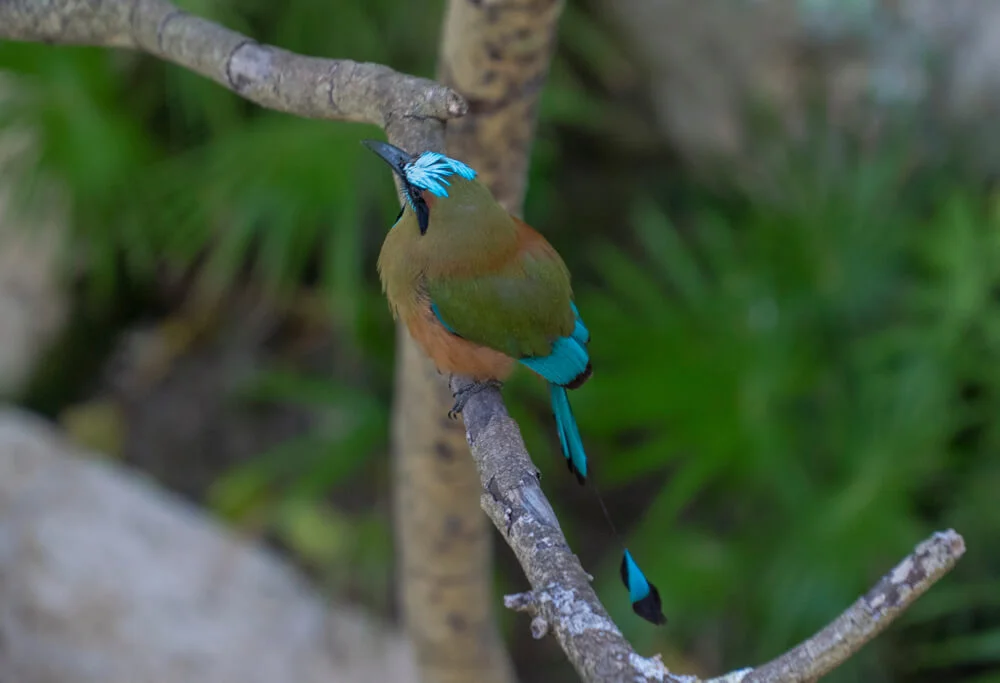Bird Toh and Ceiba tree: symbols of Yucatán
The Yucatan region is a fascinating destination that combines natural beauty, ancestral history, and cultural diversity. We invite you to discover two of its most representative species: the Toh Bird and the Ceiba Tree, which in addition to being part of the rich flora and fauna of the area, have a profound meaning for the Mayan civilization, which inhabited and flourished in these lands for centuries. The Mystical Toh Bird: Sacred and Symbolic Bird of the Mayan Jungle The Toh Bird, also known as the clock bird, jut-jut bird, blue-browed motmot, or blue-crowned motmot, is a bird of extraordinary beauty. It is distinguished by its green plumage with blue and black details, its thick, curved beak, and a long, forked tail that swings like a pendulum. Its name is onomatopoeic, imitating the characteristic sound it makes: “mot mot.” Habitat and Behavior of the Toh Bird The Toh Bird lives in the tropical jungles of Yucatan, Guatemala, Belize, and Honduras. Its diet includes insects, fruits and small reptiles. It prefers to nest in tree cavities or in ravines near water streams. This bird usually lives alone or in pairs, and its melancholic song is heard especially at dawn and dusk. The Mayan Legend of the Toh Bird For the Mayans, the Toh Bird was a sacred bird that symbolized the connection between the earthly world and the underworld, known as Xibalba. According to legend, the Toh Bird was one of the most beautiful and vain birds in the jungle. It refused to work and collaborate with other birds, dedicating itself only to showing off its tail and making fun of others. One day, the owl, considered the wisest of all, announced the arrival of a terrible storm. All the birds began to build a shelter, except for the Toh Bird, who made fun of them and retreated to its nest. The storm swept everything away, and the Toh Bird lost its nest and its tail. Desperate, he sought help from the other birds, but no one wanted to help him. The Pact with the Lords of Xibalba The Toh Bird took refuge in a cave, where he found the lords of Xibalba. They offered to give him back his tail in exchange for him becoming their messenger, guiding the humans who entered the underworld. The Toh Bird accepted, and since then, his tail has two fewer feathers, as a symbol of his pact with the lords of Xibalba. Meaning and Observation of the Toh Bird Today The Toh Bird became a symbol of humility and solidarity for the Mayans. Today, it can be seen in cenotes such as Zazil Tunich, where it is said that there is a portal to Xibalba. Its presence in these places allows us to appreciate both its beauty and its mysticism. The Ceiba Tree: The Tree of Life and the Cosmos The Ceiba Tree, also known as pochote, kapok or yaxché, is the largest tree in Yucatan, reaching up to 70 meters in height and 3 meters in diameter. Its trunk is thick and thorny, with tabular roots that give it stability. Its leaves are compound and palmate, its white or pink flowers have a sweet aroma, and its fruits are woody capsules with seeds wrapped in cottony fiber. It is found throughout tropical America, from Mexico to Brazil, in dry or humid areas near rivers or cenotes. Its light and resistant wood is used for canoes and crafts, its waterproof fiber for pillows, and its seeds for oil. It has medicinal properties in leaves, flowers and bark. For the Mayans, the Ceiba Tree was sacred, representing the cosmic axis that connected heaven, earth and the underworld. Its branches were the sky with gods and ancestors, its trunk the earth with humans and animals, and its roots the underworld with dark forces. It had four branches facing the cardinal points: – East (red): fire, sun, god Kinich Ahau, quetzal.– West (black): water, night, god Chaac, jaguar.– North (white): air, wind, god Kukulkán, feathered serpent.– South (yellow): earth, rain, god Itzamná, toad. The ceiba tree is still revered in Yucatán as a symbol of Mayan identity and culture, where it is admired and respected. Zazil Tunich: a cenote that connects you with the nature and culture of Yucatán If you want to live a unique and unforgettable experience in the Yucatán region, we recommend visiting Zazil Tunich, a private cenote with a guided experience that will make you feel part of the nature and culture of this place. Zazil Tunich means “luminous stone” in Mayan, and it is a cenote-cavern that is located 20 meters underground, where you can admire thousands of stalactites and stalagmites that form whimsical and surprising figures. Zazil Tunich offers you a 200-meter tour inside the cavern, where you can learn about the history, mythology and importance of cenotes for the Mayans, who considered them entrances to Xibalbá, the underworld. At the end of the tour, you will reach a cenote with crystal-clear, shallow waters, where you can swim and cool off, surrounded by a magical and mysterious atmosphere. Don’t think twice, and reserve your place now at Zazil Tunich, the cenote that connects you with the nature and culture of Yucatan. We guarantee that it will be an experience that you will never forget, and that will make you feel part of this wonderful place. For more information, visit our website, where you will find high-quality images and videos that will show you the beauty of Zazil Tunich, as well as testimonies from people who have already lived this adventure. You can also contact us at 985 808 5827, and we will be happy to assist you. Don't miss this opportunity and come and see the Toh Bird and the Ceiba Tree, two symbols of the nature and culture of Yucatan, at Zazil Tunich, the cenote that awaits you. www.zaziltunich.com/reservaciones Visit the only Cenote & Museum Reserve here National Award Share this entry:

